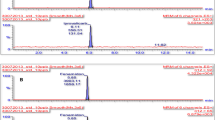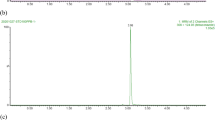Abstract
The aim of this study was to increase the knowledge in the field of bioavailability of pollutants in agricultural food samples. Bioavailability of flufenoxuron, lufenuron, pyriproxyfen and fenoxycarb was studied in a common commodity as mandarin in vitro. Not only was it studied in fresh fruit but also in standards and canned mandarin to be able to establish matrix-related differences. Human gastric digestion, intestinal digestion and absorption were imitated. Porcine pepsin, porcine pancreatin, bile salts and semipermeable cellulose dialysis tubing were used. Dialysis values were lower than 15% and followed this order: standards > processed samples > fresh samples. The highest dialyzable values were observed for fenoxycarb and pyriproxyfen. The higher the digested amount of pesticide, the higher the dialysed amount.





Similar content being viewed by others
References
Chester G (1993) Evaluation of agricultural worker exposure to, and absorption of, pesticides. Ann Occup Hyg 37:509–524
Chiplonkar SA, Agte VV, Tarwadi KV, Kavadia R (1999) In vitro dialyzability using meal approach as an index for zinc and iron absorption in humans. Biol Trace Elem Res 67:249–256
DG SANCO (2007) Method validation and quality control procedures for pesticide residues analysis in food and feed, document no. SANCO/2007/3131. European Commission, Brussels
DG SANCO (Directorate-General for Health and Consumers) (2005) Regulation (EC) no. 396/2005 of the European parliament and of the council of 23 February 2005 on maximum residue levels of pesticides in products of plant and animal origin. European Commission, Brussels
Gamón M, Sáez A, Pelegrí R, Peris I, De La Cuadra JG, Coscollá R (1998) Liquid chromatographic determination of five benzoylurea insecticides in fruit and vegetables. J AOAC Int 81:1037–1042
Gil-Izquierdo A, Zafrilla P, Tomás-Barberán FA (2002) An in vitro method to simulate phenolic compound release from the food matrix in the gastrointestinal tract. Eur Food Res Technol 214:155–159
Godfrey CRA (1995) Agrochemicals from natural products. Marcel Dekker, New York
ISO (International Organization for Standarization) (2005) ISO/IEC 17025:2005: general requirements for the competence of testing and calibration laboratories. ISO, Geneva
Lee PW (2003) Handbook of residue analytical methods for agrochemicals. Wiley, Sussex
Miller DD, Schricker RB, Rasmussen RR, Van Campend D (1981) An in vitro method for estimation of iron availability from meals. Am J Clin Nutr 34:2248–2256
Moody RP, Chu I (1995) Dermal exposure to environmental contaminants in the great lakes. Environ Health Perspect 103:103–114
Newton JM, Razzo FN (1977) The in vitro bioavailability of various drugs formulated as hard gelatin capsules. J Pharm Pharmacol 29:205–208
Payá P, Oliva J, Cámara MA, Barba A (2007a) Dissipation of insect growth regulators in fresh and canned fruits. Int J Environ Anal Chem 87:971–983
Payá P, Mulero J, Oliva J, Cámara MA, Zafrilla P, Barba A (2007b) Bioavailability of insect growth regulators in citrus and stone fruits. Comm Appl Biol Sci Ghent University 72:151–159
Poet TS, Wu H, Kousba AA, Timchalk C (2003) In vitro rat hepatic and intestinal metabolism of the organophosphate pesticides chlorpyrifos and diazinon. Toxicol Sci 72:193–200
Schricker BR, Miller DD, Rasmussen RR, Van Campen D (1981) A comparison of in vivo and in vitro methods for determining availability of iron from meals. Am J Clin Nutr 4:2257–2263
Shargel L, Yu AB (1999) Applied biopharmaceutics & pharmacokinetics. McGraw-Hill, New York
Tomlin CDS (2004) The e-pesticide manual: a world compendium. British Crop Protection Council, Farnham
Umbreit TH, Hesse EJ, Gallo MA (1986) Bioavailablity of dioxin in soil from a 2, 4, 5-T manufacturing site. Science 232:497–499
Umbreit TH, Hesse EJ, Gallo MA (1988) Bioavailablity and cytochrome P-450 induction from 2, 3, 7, 8-tetrachlorodibenzo-p-dioxin contaminated soils from Times Beach, Missouri, and Newark, New Jersey. Drug Chem Toxicol 11:405–418
US EPA (United States Environmental Protection Agency) (2006) Terminology reference system. US EPA, Washington, DC
Wester RC, Mobayen M, Maibach HI (1987) In vivo and in vitro absorption and binding to powered stratum corneum as methods to evaluate skin absorption of environmental chemical contaminants from ground and surface water. J Toxicol Environ Health 21:367–374
Wolters MGE, Schreuder HA, van den Heuvel G, van Lonkhuijsen HJ, Hermus RJ, Voragen AG (1993a) A continuous in vitro method for estimation of the bioavailability of minerals and trace elements in foods: application to breads varying in phytic acid content. Br J Nutr 69:849–861
Wolters MGE, Diepenmaat HB, Hermus RJJ, Voragen AGJ (1993b) Relation between in vitro availability of minerals and food composition: a mathematical model. J Food Sci 58:1349
Acknowledgments
Science and Technology Plan 2003–2006, Science and Technology Agency-Fundación Séneca of the Region of Murcia (SE Spain), Project 00538-PI-04. Fundación Séneca fellowships.
Author information
Authors and Affiliations
Corresponding author
Rights and permissions
About this article
Cite this article
Payá, P., Oliva, J., Zafrilla, P. et al. Bioavailability of insect growth regulator residues in citrus. Ecotoxicology 18, 1137–1142 (2009). https://doi.org/10.1007/s10646-009-0394-2
Received:
Accepted:
Published:
Issue Date:
DOI: https://doi.org/10.1007/s10646-009-0394-2




